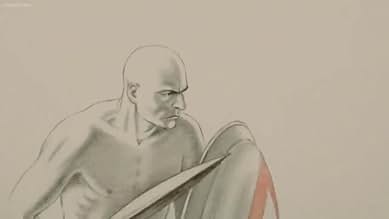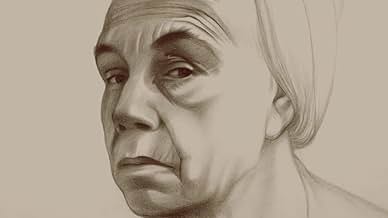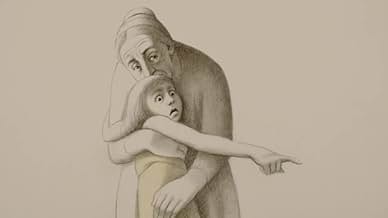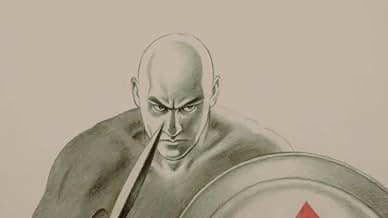IMDb-BEWERTUNG
6,5/10
1322
IHRE BEWERTUNG
Füge eine Handlung in deiner Sprache hinzuTaking place 2,400 years in the past, Prologue depicts a brutal battle between two teams of Spartan and Athenian warriors.Taking place 2,400 years in the past, Prologue depicts a brutal battle between two teams of Spartan and Athenian warriors.Taking place 2,400 years in the past, Prologue depicts a brutal battle between two teams of Spartan and Athenian warriors.
- Regie
- Drehbuch
- Für 1 Oscar nominiert
- 2 Nominierungen insgesamt
Empfohlene Bewertungen
The animation was exellent, I give it a 8 stars because as a person who is into historical reenacment I found some pieces historically innacurate with the way figures fought and were equipt but this can be forgiven because this animation shows 4 skirmishers not hoplites.
The negative reviews I have seen so far are a testiment to human deniel and misinformation/lack of infomation. The animation has a story, it's the Peloponissian war, a war that happened not a fantastic event that most of your might think. It potrays perfectly the gruesomeness of such combat instead of making it look like a hero movie like most pieces of modern cinema do. For all those who review this movie negatively and actaully think what they are waching is just two guys killing each other for just cause then you have nothing more to do but to simply open a history book to realise this doesn't just have a story but it's a recreation of a real moment in human history.
This laughably inaccurate short was to be the introduction to a cartoon adaption of Lysistrata. The press material says: "Man against man and sword against spear, the soldiers are determined to sacrifice themselves for a greater purpose"
"man against man"? Classical age conflict between Greek city states was NOT melee pairing it was phalanx warfare. That is almost ritualized and surprising low violence, with an estimated 5% casualty rate per battle. Violence was almost entirely confined to combatants and phalanx fighting was essentially set piece pushing matches. There was virtually no "man against man" fighting at all.
That the cartoons was utterly inaccurate in detail as well is also important since the the details go to bigger issues. The greaves ALL hoplites wore and the type of shield (the word hoplite means shield warrior), and the standard length spear ALL had were for fighting in FORMATION. And the formation (the phalanx) reflected the citizen warrior fighting in a unified group -- as part of their responsibility to their city state and their fellow citizen warriors. Breaking off for melee pairings as in "Prologue" as it itself an act against one's fellow citizens since it compromised the phalanx.
Each citizen had to privately own the infantry arms and amour. This was an important part of egalitarian underpinnings of most city states.
The reason the Eight to Fifth century BC city states did not subjugate huge amounts of foreigners is because their fighting method, citizen, non professional solders who had their own equipment. Assyrians, Persians, later Macedonian Greeks, and empire period Romans all had armies were paid or impressed soldiers, who did not own their weapons and who were permanent professional soldiers. those other forces did NOT have to get back to the fields or regular jobs" like Lysistrata era Greeks had to.
The cartoonist completely misses the point: If warfare today was like classical age Greek warfare, with its lack of full time professional soldiers, with its lack of central armories, but instead owned arms, with its "winning" by having 5% or so of combatants die on the field, and victory declared, instead of "total war" with its lack of razing cities in most cases -- we would be a LOT better off.
The author/cartoonist, and anyone interested, ought to read the preeminent scholar on Lysistrata era Hoplite warfare: Victor Davis Hanson's "Hoplites: The Classical Greek Battle Experience" so they do not get confused.
"man against man"? Classical age conflict between Greek city states was NOT melee pairing it was phalanx warfare. That is almost ritualized and surprising low violence, with an estimated 5% casualty rate per battle. Violence was almost entirely confined to combatants and phalanx fighting was essentially set piece pushing matches. There was virtually no "man against man" fighting at all.
That the cartoons was utterly inaccurate in detail as well is also important since the the details go to bigger issues. The greaves ALL hoplites wore and the type of shield (the word hoplite means shield warrior), and the standard length spear ALL had were for fighting in FORMATION. And the formation (the phalanx) reflected the citizen warrior fighting in a unified group -- as part of their responsibility to their city state and their fellow citizen warriors. Breaking off for melee pairings as in "Prologue" as it itself an act against one's fellow citizens since it compromised the phalanx.
Each citizen had to privately own the infantry arms and amour. This was an important part of egalitarian underpinnings of most city states.
The reason the Eight to Fifth century BC city states did not subjugate huge amounts of foreigners is because their fighting method, citizen, non professional solders who had their own equipment. Assyrians, Persians, later Macedonian Greeks, and empire period Romans all had armies were paid or impressed soldiers, who did not own their weapons and who were permanent professional soldiers. those other forces did NOT have to get back to the fields or regular jobs" like Lysistrata era Greeks had to.
The cartoonist completely misses the point: If warfare today was like classical age Greek warfare, with its lack of full time professional soldiers, with its lack of central armories, but instead owned arms, with its "winning" by having 5% or so of combatants die on the field, and victory declared, instead of "total war" with its lack of razing cities in most cases -- we would be a LOT better off.
The author/cartoonist, and anyone interested, ought to read the preeminent scholar on Lysistrata era Hoplite warfare: Victor Davis Hanson's "Hoplites: The Classical Greek Battle Experience" so they do not get confused.
War is hell and it always has been. I think that sometimes when animation is used, it is thought to be cartoon-like in the kindest sense. So when the realities of face to face battle are portrayed we seem to believe that we've somehow been betrayed by the filmmaker. There are no winners here, only the slaughter of our opponents and the end is meaningless. The face of he child and the old woman, wonderfully portrayed, are what should be etched in our memories. There is nothing clean about war and this shows it in spades.
First of all, anyone who watches this can easily see why parents were advised to remove their children from the theater before it was presented.
The animation is -- STUNNINGLY Beautiful! I can see why another reviewer mistook the story as an tiny war, but I felt it was depicting Athens/Sparta.
The story is pointlessly grim and violent. As an aside, I doubt any man would find it comfortable to fight without at least underwear, if not shorts on. The dangling genitalia was unnecessary to the story, I cannot see one reason it was done.
What is it supposed to be? Is it supposed to speak to the violence and loss of war? Is that something our world doesn't understand, hence a need to waste the (considerable) effort of the artist on? No.
The entire time I was watching it I was frustrated by the wasted talent. He should find a new writer give him a story worthy of his work.
The animation is -- STUNNINGLY Beautiful! I can see why another reviewer mistook the story as an tiny war, but I felt it was depicting Athens/Sparta.
The story is pointlessly grim and violent. As an aside, I doubt any man would find it comfortable to fight without at least underwear, if not shorts on. The dangling genitalia was unnecessary to the story, I cannot see one reason it was done.
What is it supposed to be? Is it supposed to speak to the violence and loss of war? Is that something our world doesn't understand, hence a need to waste the (considerable) effort of the artist on? No.
The entire time I was watching it I was frustrated by the wasted talent. He should find a new writer give him a story worthy of his work.
'PROLOGUE': Three and a Half Stars (Out of Five)
A 6 minute British animated short film; about a gruesome battle, between Spartan and Athenian warriors (2,400 years ago), as seen through the eyes of a young girl. The short is extremely violent, and it also contains full frontal (animated) male nudity. It was directed, and animated, by Richard Williams; and it was produced by Imogen Sutton (Williams' wife). The battle scene is really well done; brilliantly animated and very realistic looking. There's not a lot to the movie, other than that though; a little girl sees it, and she's heartbroken by it. The animation is extremely impressive; but it's my least favorite, of this year's Academy Award nominated animated shorts.
Watch our movie review show 'MOVIE TALK' at: https://youtu.be/b_aLk3J5gh4
A 6 minute British animated short film; about a gruesome battle, between Spartan and Athenian warriors (2,400 years ago), as seen through the eyes of a young girl. The short is extremely violent, and it also contains full frontal (animated) male nudity. It was directed, and animated, by Richard Williams; and it was produced by Imogen Sutton (Williams' wife). The battle scene is really well done; brilliantly animated and very realistic looking. There's not a lot to the movie, other than that though; a little girl sees it, and she's heartbroken by it. The animation is extremely impressive; but it's my least favorite, of this year's Academy Award nominated animated shorts.
Watch our movie review show 'MOVIE TALK' at: https://youtu.be/b_aLk3J5gh4
Wusstest du schon
- WissenswertesThis is the first mature cartoon by Richard Williams to depict graphic violence, blood and full frontal nudity.
- VerbindungenFeatured in The Oscar Nominated Short Films 2016: Animation (2016)
Top-Auswahl
Melde dich zum Bewerten an und greife auf die Watchlist für personalisierte Empfehlungen zu.
Details
- Laufzeit6 Minuten
- Farbe
- Seitenverhältnis
- 1.78 : 1
Zu dieser Seite beitragen
Bearbeitung vorschlagen oder fehlenden Inhalt hinzufügen



















